There are a couple of things to note here.
First, you need to be careful about measuring just the current and using that as a proxy for power consumption. This is a valid assumption for a purely resistive load, but not for any significantly inductive or capacitive load (motors tend to be quite inductive).
Reactive loads (ie: inductive or capactive loads) store energy throughout part of the waveform and release it at other times. This manifests as a circulating current and a phase shift between the voltage and current at the load terminals. This means that the actual power consumed (and billed for) will be less than what is measured if you just reckon the consumption based on the current. For further details, see the Wikipedia entry on apparent and real power.
In your case, your pool heater should look like an almost perfectly resistive load, so your apparent power should be basically equal to your real power (or close enough for your purposes). Just keep in mind that if you wanted to use the same sort of sensor to meter the power on something like a circulating pump, you wouldn't get accurate results.
In terms of your calculation, you are correct. Assuming that your inductive current sensor integrates and computes energy consumption assuming 120 V delivered to the load (you should check this), it will read half the true value on a 240 V system. To put it mathematically:
$$ P_{meas}=V_{rms}I_{rms}=120I $$
But if \$V_{rms}\$ is actually 240 V:
$$ P_{actual}=V_{rms}I_{rms}=240I $$
Then we can say:
$$ \frac{P_{meas}}{P_{actual}} = \frac{120I}{240I} = \frac{1}{2}$$
Energy consumed is just the integral of power:
$$ E(t) = \int_{0}^{t}P(t)\,dt $$
And since \$P_{actual} = 2P_{meas}\$, and since integration is linear operation, we can state:
$$ E_{act}(t) = \int_{0}^{t}P_{actual}(t)\,dt = \int_{0}^{t}2P_{meas}(t)\,dt = 2\int_{0}^{t}P_{meas}(t)\,dt $$
$$ E_{meas}(t) = \int_{0}^{t}P_{meas}(t)\,d $$
Thus:
$$ E_{act}(t) = 2E_{meas}(t) $$
So, you can get your actual consumed power by doubling your measured power.
One final note - 120V and 240V are the nominal voltages for single and split-phase in North America, but depending on where you live, the values can vary by up to 10%. If your meter does not measure the line voltage, you can expect a 10% tolerance on your measured energy. Probably fine for your application, but something to keep in mind.
